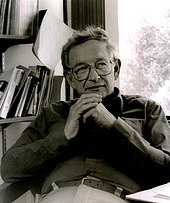Philip Warren Anderson
Philip Warren Anderson (born December 13, 1923 in Indianapolis , Indiana , † March 29, 2020 in Princeton , New Jersey ) was an American theoretical physicist . Together with Nevill F. Mott and John H. Van Vleck, he received the Nobel Prize in Physics in 1977 “for the fundamental theoretical achievements on electronic structure in magnetic and disordered systems”.
Scientific career
Anderson grew up in Urbana , Illinois and studied at Harvard University , where he worked at the US Naval Research Laboratory while undergraduate. In 1943 he received his BS degree and in 1949 his PhD in physics from Harvard University with John H. Van Vleck .
From 1949 to 1984 he was at Bell Laboratories in New Jersey , where he was head of the department for theoretical physics from 1959 to 1961. From 1974 to 1976 he was Deputy Director of the Physics Laboratory and from 1976 to 1982 its Consulting Director. At the same time he was a visiting fellow at the University of Cambridge from 1961 to 1962 and held a professorship for theoretical physics at the same university from 1967 to 1975 (as a fellow of Jesus College). In 1975 Anderson went back to the United States and became Joseph Henry Professor of Physics at Princeton University . From 1997 Philip W. Anderson was emeritus at the university there. In addition, he was from 1985 professor at the Santa Fe Institute , in whose direction he was also active.
From 1982 to 1986 he was Chairman of the Board of Trustees of the Aspen Center for Physics .
research
Anderson dealt with condensed matter theory (solid state physics) with a focus on magnetism , disordered systems and quantum fluids . He also dealt with fundamental problems in quantum physics such as broken symmetries, but also line broadening and the like. a. He was responsible for the concept of Anderson localization . In the 1990s he also developed his own theories about high-temperature superconductors .
In addition to these main areas of research, Philip W. Anderson was particularly interested in biophysics , neural networks , computers and complexity . Anderson is also considered an important natural-philosophical thinker in his discipline, including in the field of emergence . In this context, his science article More is different from 1972 is best known .
Prices
Philip W. Anderson has received numerous awards and honors for his research. The most important of these are (in chronological order):
- 1963 member of the American Academy of Arts and Sciences
- 1964 Oliver E. Buckley Condensed Matter Prize from the American Physical Society
- 1967 member of the National Academy of Sciences
- 1975 Dannie Heineman Prize of the Göttingen Academy of Sciences
- 1977 Nobel Prize in Physics
- 1980 Fellow of the American Association for the Advancement of Science
- 1983 National Medal of Science
- 1991 member of the American Philosophical Society
- 1994 Foreign member of the Russian Academy of Sciences
- 1997 John Bardeen Prize
Life outside of physics
Anderson was a certified 1- Dan (1st master degree) of the Japanese board game Go .
Fonts
- Concepts in solids. Lectures on the theory of solids. Addison-Wesley, Redwood City CA et al. a. 1992, ISBN 0-201-53355-3 (World Scientific, Singapore et al. 1997, ISBN 981-02-3195-4 ).
- A career in theoretical physics (= World Scientific Series in 20th Century Physics. Vol. 7). World Scientific, Singapore et al. a. 1994, ISBN 981-02-1717-X (reprint collection).
- Basic notions of condensed matter physics (= Frontiers in Physics. Vol. 55). Benjamin-Cummings, Menlo Park CA et al. a. 1984, ISBN 0-8053-0220-4 (Addison-Wesley, Reading MA 1997, ISBN 0-201-32830-5 ).
- The Theory of Superconductivity in the High Cuprates. Princeton University Press, Princeton NJ u. a. 1997, ISBN 0-691-04365-5 .
- More and Different - Notes from a Thoughtful Curmudgeon. World Scientific, Singapore et al. a. 2011, ISBN 978-981-4350-12-9 (collection of reviews and essays).
literature
- N. Phuan Ong, Ravin N. Bhatt (Eds.) More is different. Fifty years of condensed matter physics. Princeton University Press, Princeton NJ u. a. 2001, ISBN 0-691-08866-7 (Conference in Honor of Anderson, Aspen 2000).
- Patrick A. Lee and N. Phuan Ong: Philip W. Anderson (1923-2020). In: Science . Volume 368, No. 6490, 2020, p. 475, doi: 10.1126 / science.abc1042 .
- Piers Coleman: Philip W. Anderson (1923-2020). Nobel winner who transformed condensed-matter and particle physics. In: Nature . Volume 581, 2020, p. 29, doi: 10.1038 / d41586-020-01318-4 .
Web links
- Philip W. Anderson website. Princeton University
- Information from the Nobel Foundation on the 1977 award ceremony for Philip W. Anderson (English)
- PW Anderson. In: Physics History Network. American Institute of Physics
- Oral History Interview by Anderson 1999, AIP, Niels Bohr Library
- Oral History Interview 1987, AIP, Niels Bohr Library
Individual evidence
- ^ Scott Veale: Philip W. Anderson, Nobel Laureate in Physics, Is Dead at 96. In: NYTimes.com. March 30, 2020, accessed March 31, 2020 .
- ↑ Anderson: Absence of Diffusion in Certain Random Lattices. In: Phys. Rev. Volume 109, 1958, pp. 1492-1505.
- ↑ Philip W. Anderson: More is different . In: Science . tape 177 , 1972, pp. 393 , doi : 10.1126 / science.177.4047.393 , JSTOR : 1734697 (English).
- ↑ Андерсон Филип Уоррен. Website of the Russian Academy of Sciences.
| personal data | |
|---|---|
| SURNAME | Anderson, Philip Warren |
| ALTERNATIVE NAMES | Anderson, Philip W. |
| BRIEF DESCRIPTION | American physicist |
| DATE OF BIRTH | December 13, 1923 |
| PLACE OF BIRTH | Indianapolis , Indiana |
| DATE OF DEATH | March 29, 2020 |
| Place of death | Princeton , New Jersey |

